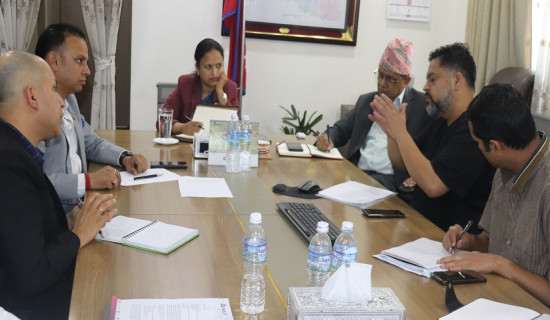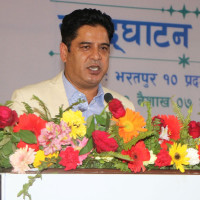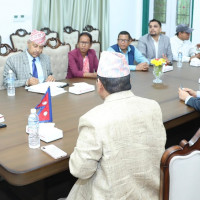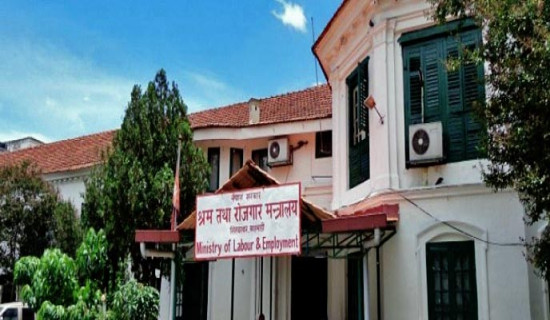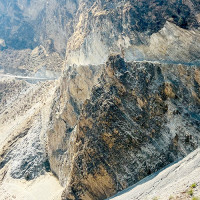- Friday, 19 April 2024
Oldest Bhagawati temple in Palanchowk pulls crowd
By Kedar Timalsina
Kavrepalanchowk, Sept. 27: The Palanchowk Bhagawati Temple in Panchkhal Municipality–9, Kavrepalanchowk district is widely held to be the oldest Bhagawati temple of Nepal.
Built more than 1,500 years ago in the fifth century AD, the temple, as the name suggests, is dedicated to goddess Palanchowk Bhagawati, the elder sister of all other Bhagawatis of the country.
The story has it that the idol of Palanchowk Bhagawati presently housed in its temple in Panchkhal once sat at another spot in the district at Buchakot. One night, the goddess appeared to the local elders in their dreams and asked them to remove her statue from its present location and take it north.
The next morning, the elders gathered and discussed among themselves. They pondered on the common dream they all saw and concluded that they needed to fulfil the goddess’s wish. So, they carried her idol and started walking north.
When they reached the site where the Bhagwati temple is located today, night fell. So, they decided to stop and resume their journey the next morning. However, at dawn, they could not pick up the idol no matter how hard they tried. “At the time, 60 families lived in this area and even when they all tried to lift it, the statue did not budge. This made everyone feel that the goddess wanted to stay here and thus, they left her here and built a temple,” explained Shaileshwor Bajracharya, priest at the Palanchowk Bhagawati Temple.
To this day, the place where the temple stands is known as Sathighar Bhagawati, referring to the Palanchowk Bhagawati and the 60 households (Sathighar) that lived here back then.
The Palanchowk Bhagwati Temple is believed to have been built in 425 AD. Legend has it that the masons built the three storeyed pagoda structure using only their right hand.
On a similar note, the builders are considered to have only used their right hands when building the Nala Bhagawati Temple in Nala, Kavre as well. Likewise, people who built the Naxal Bhagawati Temple at Naxal, Kathmandu are said to have used only their left hand. Meanwhile, the idol of Shova Bhagawati placed in its temple in Kathmandu is supposed to have been carved by artisans using their feet.
Palanchowk Bhagawati, though, is older than all the other Bhagawatis. Unlike other Bhagawatis, the head of this idol is also slightly tilted to the west. However, that is not a religious feature and is, in fact, a damage caused by the earthquake of 1934, the priest informed.
The Bajracharyas from Makhan near the Hanumandhoka Palace perform the daily worship at the Palanchowk Bhagwati Temple. They were the ones granted permission to carry out the day-to-day rituals as well as special Guthi ceremonies associated with the temple after its construction.
“We have been performing the worship here for about nine generations now,” priest Bajracharya shared.
Bajracharya informed that devotees from as far as India came to Palanchowk to pray at the temple, having full faith that the goddess will fulfil their wishes. Additionally, tourists also come to the area to view the snow-capped mountains that can be seen to the north of the temple and the green fields present to its south.
“The atmosphere here is generally calm and peaceful. However, that peace gets disturbed when a calamity is about to befall on the country and beads of sweat appear on the idol of the goddess,” Bajracharya said.
He also recounted an incident in 1973 when King Birendra suddenly arrived at the temple without any information or preparation. He returned a year later to formally worship at the temple as the country’s reigning monarch.
The second visit was particularly notable because after that, the government replaced the temple’s tin roof with brass one.
With the beginning of Dashain now, Bajracharya informed that pilgrims would come from all over the country to offer sacrifices of animals including ducks, goats and he-buffaloes. On the 11th day of Bada Dashain, that is Ekadashi, and on the full moon day of the Nepali month of Baisakh, the Bhagawati idol is removed from its sanctum and taken around the temple in a chariot. The temple also sees a large number of pilgrims on the day of Maghe Sankranti and the full moon day of Jestha.
Historical records show that multiple “officials” including priests, Guthi members, tailors, butchers, cleaners and musicians were posted at the temple for its maintenance and for the performance of the necessary rituals following the unification of Nepal by King Prithvi Narayan Shah. The temple once also had around 1,800 Ropanis of land in Baluwa, Dolalghat, Panchkhal, Hokse and other locations in and around Kavre to serve as sources of income.



